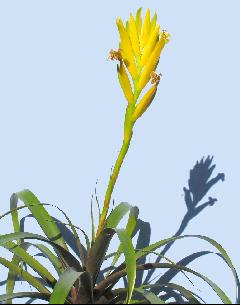
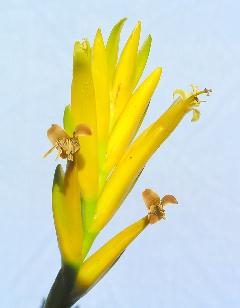
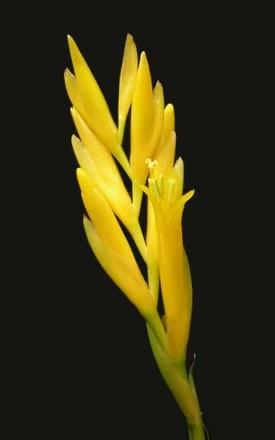
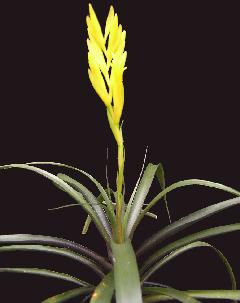
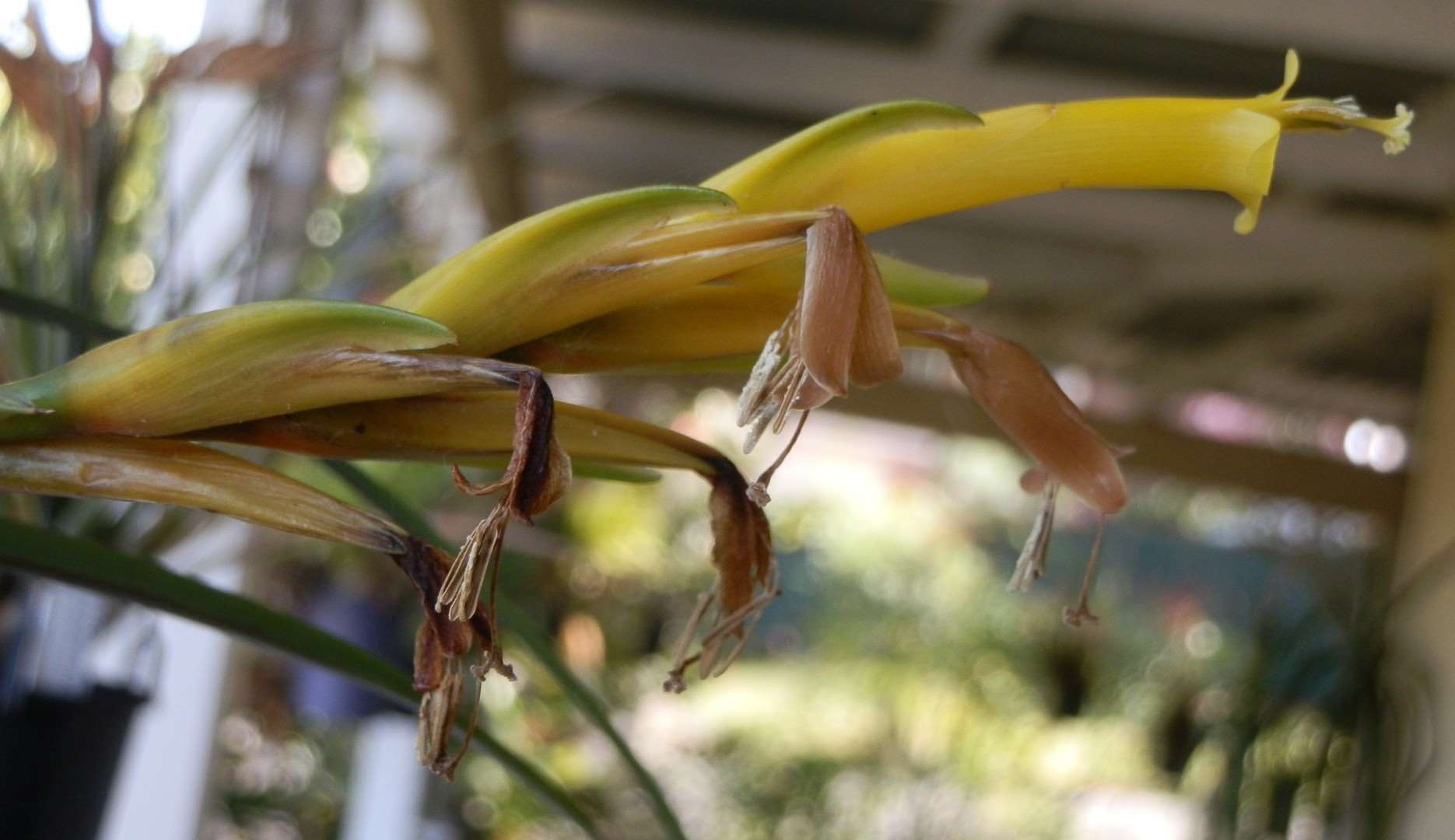
V. bleheri ROETH et WEBER f. ATROVIOLACEIFOLIA ROETH et WEBER fo. nova
A forma typica foliis utrinque atroviolaceis differt.
HOLOTYPUS: HAL No.43409
ISOTYPUS: Herbarium Bradeanum HB No. 67001
Note sometimes called bleherae but strictly should be bleherorum. See below.
Desc from JBS
PLANT stemless, flowered about 40 cm high, bearing at base numerous seedling-like plantlets;
LEAVES many, rosulate, divergent to recurved, inconspicuous adpressed lepidote;
SHEATHS distinct, long-ovate, about 6 cm long, 4 cm wide, with dry membranaceous margins, the outer surface dark violet, the inner side brownish-purpurascent;
BLADES narrowly triangular to linear, long acuminate, canaliculate, above the sheaths 15- 18 mm wide, 20 - 35 cm long, above dark green, below dark violet;
SCAPE erect to ascendent, glabrous, about 20 cm long, 5 mm in diameter;
SCAPE BRACTS erect, enfolding the scape, about equal to the 30 mm long internodes, the lower ones with suberect foliaceous blades, the upper ones only caudate;
INFLORESCENCE simple, distichous, compressed, 10 - 12 cm long, 8 - 12 flowered, before anthesis dense and imbricate, after anthesis lax and the rhachis visible;
RACHIS geniculate, yellowish-green and reddish tinged, glabrous, stout, in cross-section semiorbicular;
FLOWER BRACTS broad-lanceolate, even, glabrous, at apex sharply carinate and compressed, the lower half ecarinate but with very stout middle nerve, stiff-coriaceous, with hyaline margins, at apex green, at basis bright yellow, 35 mm long, 22 mm wide;
FLOWERS sessile, 55 mm long, yellow;
SEPALS 38 - 40 mm long, 14 mm wide, longer than the flower bracts, equal, free, ecarinate but with thickened middle nerve, glabrous, faintly nerved, apex rounded and inconspicuous apiculate, pale yellow;
PETALS 55 mm long, 8 mm wide, their blades only slightly flared (10 mm), rounded, recurved, bright yellow, at the inner base bearing two long-ovate ligula, 12 mm long, to 2/3 connate with the petals and 2 mm wide, the free part 3.5 mm wide;
STAMENS about 55 mm long, yellowish-white, subequal to exerted;
ANTHERS linear, 7 - 8 mm long, dorsifixed, dorsal green, connective dark brown, pollen grains bright yellow;
STYLUS 60 mm long, yellowish-white, stigmata spreading and at apex fimbriated;
OVARY long-coniforme, 7 - 8 mm high, pale yellowish-green.
Habitat: Brazil, Estado do Rio de Janeiro, Serra dos Orgao, alt. 100- 200 msm. leg.: Amanda and Michael Bleher No.3 - July 1975.
HOLOTYPUS: HAL No.43408, ISOTYPUS: HB No.67000.
Vriesea bleheri forma atroviolaceifolia.
With dark violet on both sides of the leaves
Vriesea bleheri resembles none of the known Brazilian species. In coloration and shape of the inflorescence it is similar to the Bolivian Vr. maxoniana (L. B. Smith) L. B. Smith, but differs from it in leaf shape and especially in the larger, ecarinate sepals, which extend beyond the flower bracts. (See the color plate in Rauh, Bromelian vol. I (1970)).
Vriesea bleheri is not difficult in cultivation. In the winter I keep it moderate to cool with a minimal temperature of 10 C; in the Botanical Garden at Halle they are grown in the warm greenhouse. The only difference is in the faster growth under the warmer conditions. The regular bloom cycle is remarkable. The bloom time has always been in December regardless of whether the plant has been grown warm or cool. It is also noted that immature specimens have also produced some inferior inflorescences. It is difficult, however, to classify Vr. bleheri clearly in the sections VRIESEA or XIPHION, which will differ according to the relative length of the stamens and the petals. In my specimens grown in the cool greenhouse (the drawings in BRADEA) the stamens were approximately equal in length to the petals; accordingly they should be classified in the section XIPHION. In the specimens grown in Halle under warmer conditions the stamens were distinctly longer than the petals; therefore they belong to the section VRIESEA.
A further influence of temperature in the formation of the inflorescence is evident in the fact that in the cool-grown specimens the rachis elongates more quickly causing the inflorescence to be more open at the beginning of anthesis. The inflorescence of the warm-grown specimens, on the other hand, remains dense for a longer time and becomes open only after blooming.
Because of the dark violet leaves, the nicely shaped rosette, the brilliant yellow inflorescence and, last but not least, because of the favorite December blooming time, this new Vriesea bleheri will certainly attract the attention of commercial growers, whether as a species plant or as a hybridizing partner.
General notes
I and the Botanical Garden at Halle received simultaneously various orchids and bromeliads collected by Senhora Amanda Bleher - LOTUS OSIRIS - and by her son Michael in the summer of 1975 at the foot of the Organ Mountains. We were particularly attracted to some Vrieseas among them because of their shape and the distinctive dark violet coloration of the under side of the leaves. In some of the specimens both sides of the leaves were of this color and this coloration has not changed in the three years that they have been growing in the greenhouse. The first specimens bloomed in December 1976, others in December 1977, and it was evident that we had a hitherto unknown species. The Botanical Garden's Inspector Roeth and I published the Latin description in the bulletin of the Herbarium Bradeanum, Rio de Janeiro - BRADEA Vol. II/38 (1978) pp. 261-264. Since it is assumed that other bromeliad growers own specimens from this expedition, the English description is presented here:
Email notes on the suffix!
l8. June 1999
To multiple recipients of list
Vriesea bleheri/bleherae
Not to worry you all but this plant was named as Vriesea bleheri by Roeth and Weber in Bradea vol.II/38 (1978). It honoured BOTH Amanda AND Michael Bleher and to my mind is a bit nit-picky to change the sex some l1 years after the event. Don't the male and female cancel each other out? Surely the Botanists could think up a neutered adjective?
Uncle Derek
18 Jun 1999
Multiple recipients of list
V. bleheri/bleherae
I agree with Derek:
In this case of ambiguity which cannot be solved due to the Latin grammar, the original spelling MUST be retained!
W. Till
22 Jun 1999
TO: Multiple recipients of list
Subject: AW: Vriesea......
My understanding is that he said the feminine ending is -ae, the masculine is –I and that –a is neuter.
His problem seemed to be with Vriesea. He did not seem to think it was either proper Latin or Greek and therefore he was confused about its gender. He felt there was about an 80: 20 chance it was feminine.
If Vriesea is feminine, then the name should be Vriesea bleherae.
If Vriesea is masculine, then the name should be Vriesea bleheri.
Is there any validity to this?
Sorry, it is not. When naming a plant after a person, the epithet (species name) is the genitive of the latinized person's name. Mr. Bleher is latinised bleherus, the genitive is bleheri, Mrs. Bleher is latinised blehera, the genitive is bleherae. (An exception. is, when the persons name is ending with the vocal "a", the genitive is irrespective to the persons sex: -ae. e.g. Mr. Ochoterena = ochoterenae).
The ending of the adjective is of the same sex as that of the substantive, hence the ending of the epithet can only be one choice (male, female, or neutral). In the given situation, we have not to correct an error but are faced with the decision of the author in his dilemma (bleheri or bleherae, two persons but only one possible ending ! ), and according to my understanding of the code, especially of Art. 60.1: "The original spelling of a name or epithet is to be retained, except for the correction of typographical or orthographical errors”, we have to use the original spelling of the author.
Even if we correct to the plural, the dilemma remains: bleherorum (male) or bleherarum (female). This is a further argument to retain the original spelling.
W Till
Of course, I suppose there may be a rule about how long it takes for an improper name to be accepted. The big problem, I see in the changing of names is the potential for losing information because it is filed under a superceded name and is missed because someone missed that change in the literature.
Chas